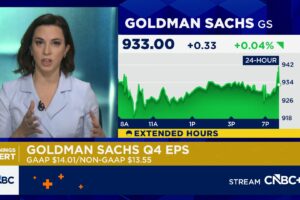
Wall Street analysts expect these semiconductor stocks to move in opposite directions over the next year.
Grand View Research forecasts artificial intelligence (AI) chip sales will grow at 29% annually through 2030. Semiconductor companies Nvidia (NVDA 3.13%) and Arm Holdings (ARM 1.22%) are major players in that market, and shares have rocketed 166% and 100%, respectivley, year to date. But most Wall Street analysts expect the stocks to move in opposite directions over the next year.
- Nvidia has a median 12-month price target of $150 per share. That implies 15% upside from its current share price of $131.
- Arm has a median 12-month price target of $144 per share. That implies 5% downside from its current share price of $151.
Going forward, Nvidia and Arm should benefit as businesses continue to build out their AI infrastructure, but that does not necessarily make them good investments. Here are the important details.
1. Nvidia
Nvidia holds 98% market share in data center graphics processing units (GPU), chips used to accelerate computationally demanding workloads like training machine learning models and running artificial intelligence (AI) applications. That dominance is more than a decade in the making. In 2006, Nvidia introduced its CUDA programming model, which has evolved into an unmatched ecosystem of software development tools for GPU programmers.
More recently, Nvidia has added networking gear and central processing units (CPUs) to its hardware portfolio, and debuted software and cloud services that simplify AI application development. In that context, while many investors view Nvidia as a chipmaker, it is more accurately an accelerated computing company. And its ability to innovate across the entire data center computing stack — from hardware to software to services — affords Nvidia a competitive moat.
Nvidia beat estimates with its financial results in the second quarter of fiscal 2025 (ended July 2024). Revenue increased 122% to $30 billion due to strong demand for AI chips, networking, and enterprise software. And non-GAAP net income increased 152% to $0.68 per diluted share. Management also gave stronger guidance than Wall Street anticipated, such that revenue is forecast to jump 80% in the third quarter.
It goes without saying that Nvidia has a tremendous opportunity where AI is concerned, but the broader data center accelerator market is equally momentous. “We are at the beginning of our journey to modernize $1 trillion worth of data centers from general-purpose computing to accelerated computing,” CEO Jensen Huang recently told analysts. He expects that transition to play out over the next four to five years.
Wall Street expects Nvidia’s adjusted earnings to increase at 35% annually through fiscal 2027 (ends January 2027). That makes current valuation of 59 times adjusted earnings look fair. Personally, I think Nvidia is a must-own stock given its level of participation in the AI economy, not to mention its leadership in the data center accelerator market. The current price is a reasonable entry point for patient investors.
2. Arm Holdings
Arm develops central processing unit architectures and licenses the intellectual property (IP) to clients, who use the IP to build custom chips for a wide range of end markets, from mobile devices and industrial sensors to data center infrastructure. Arm also provides development tools that simplify the of writing and debugging of applications.
Arm CPUs are known for their energy efficient architecture, which has helped the company secure a leadership position in mobile devices. Most importantly, Arm has more than 99% market share in smartphone processors. However, the company is also gaining share in data centers and personal computers (PCs) because its chip are becoming increasingly powerful.
Arm is well positioned to benefit as the artificial intelligence boom progresses. Its CPUs are the foundation of Apple Intelligence; they handle simple AI tasks on devices like iPhones and more complex AI tasks on private data center servers. The major public clouds (Amazon Web Services, Microsoft Azure, and Alphabet‘s Google Cloud Platform) have designed Arm-based server CPUs. And several computer manufacturers have introduced AI PCs powered by Arm processors.
Arm reported solid financial results in the first quarter of fiscal 2025 (ended June 2024), beating estimates on the top and bottom lines. Revenue increased 39% to $939 million due to momentum in the smartphone and cloud computing markets, which itself was driven by strong adoption of Arm’s latest architecture (Armv9). Meanwhile, non-GAAP net income increased 67% to $0.40 per diluted share.
Wall Street expects Arm’s adjusted earnings to grow at 27% annually through fiscal 2027 (ends March 2027). That estimate makes the current valuation of 107 times adjusted earnings look outrageously expensive. So, I think prospective investors should stay on the sidelines right now, and present shareholders should consider trimming their positions, especially if those positions comprise a substantial portion of their portfolios.
Suzanne Frey, an executive at Alphabet, is a member of The Motley Fool’s board of directors. John Mackey, former CEO of Whole Foods Market, an Amazon subsidiary, is a member of The Motley Fool’s board of directors. Trevor Jennewine has positions in Amazon and Nvidia. The Motley Fool has positions in and recommends Alphabet, Amazon, Apple, Microsoft, and Nvidia. The Motley Fool recommends the following options: long January 2026 $395 calls on Microsoft and short January 2026 $405 calls on Microsoft. The Motley Fool has a disclosure policy.











